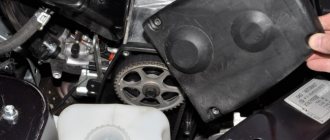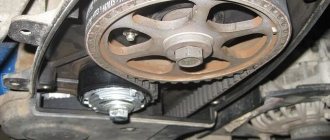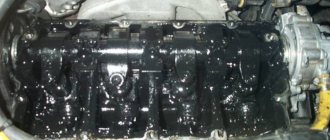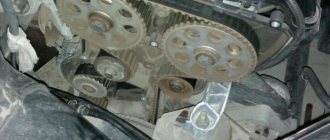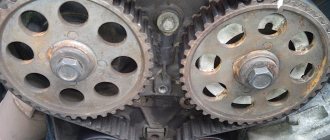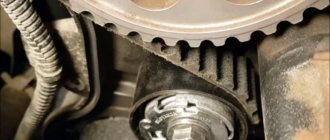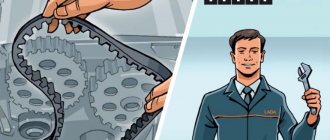What is a timing belt
Every car with an internal combustion engine has a gas distribution mechanism (GRM). It is responsible for the correct supply of the air-fuel mixture, and the timing belt synchronizes the movements of the camshaft and crankshaft. It makes the power plant work correctly and consume the normal amount of fuel.
In addition to shafts, in new engines, to save space, the part can be used in other components. It is often carried out through a water cooler; in some designs, the generator also operates from it.
Additional Information! Rubber consumables do not suffer from corrosion; they wear out from friction and time and can break at any time.
Where is the timing belt located?
First, let's remember where the timing belt is located and what it looks like. Its location is in front of the engine, but do not forget that motors come in longitudinal and transverse locations. In most cases, gas distribution mechanisms use a toothed rubber belt, but in a considerable number of car models from different manufacturers, a steel chain is also used for this.
Engine cylinders can be equipped with two or four valves with one and two camshafts (CV), respectively. The kinematics of the gas distribution mechanisms of such engines differ. We will show them using the example of 8- and 16-valve power units for the VAZ 2110, 2111 and 2112.
The scheme with two shafts is more complicated, and in it, in addition to the pulley of the second RV, a support roller is added. This also complicates the belt replacement procedure. It is most difficult to perform this operation after a break or severe stretching of the belt, when the factory timing settings can be completely lost. Replacing in normal mode is not so difficult that you can’t try to do it yourself.
Purpose of the timing belt
The main purpose of the belt is to synchronize the rotation of the crankshaft and camshaft of the internal combustion engine. If the movement of these main drives of the crank mechanism and the valve system is not synchronous, two critical malfunctions occur:
- the engine combustion chambers will lack the necessary compression;
- The ignition angle is incorrect.
In most diesel engines and many gasoline engines, a situation may arise when “the valves meet the pistons.” When purchasing a car, you need to find out the exact name of the engine model that is installed on it. This can be done using the VIN, but sometimes the engine is changed during the operation of the car, then this is more difficult to do. According to the engine model, you need to enter a query into a search engine, for example, “4G63 engine valves meet pistons” or something like that. The received links must be analyzed. If the answer is clear: “they do occur,” the timing and mileage before replacement must be observed. If the belt breaks or jumps, it will most likely lead to capital failure.
Many car enthusiasts advise purchasing a car with an engine equipped with a chain timing mechanism. It is believed that they are more reliable. It is not always so. Even if it is a million-dollar engine, this does not mean that the chain guide should not be changed in a timely manner. This work can be more labor intensive than replacing a belt.
Determining the need to replace the timing chain
As the need to replace the chain approaches, it lengthens significantly. A consumable rupture occurs extremely rarely. This is especially true for double-row chains. You can determine the presence of an extension by measuring the consumable. It will be much longer than the new product.
Comparison of new and old chain lengths
When the chain stretches, the tensioner tries to eliminate its elongation. It can be either manual or automatic. The elongation of the chain is determined by the output of its piston.
Tensioner with chain stretched
You can check for chain stretch by pulling it on the camshaft gear. If it rises by a centimeter or more, then there is a risk of the teeth jumping and such a consumable must be replaced.
Stretched camshaft chain and gear
When the timing chain stretches, a number of external symptoms of the need for replacement appear. There is a metallic knock coming from the timing drive side. It is most noticeable on a cold engine after starting. With more severe chain wear, a timing shift occurs. The engine loses power, fuel consumption increases, and the speed becomes unstable.
Modern cars have a self-diagnosis system that receives information from sensors. A symptom of the need to replace the chain is the presence of errors in the operation of the crankshaft and camshaft sensors. You can check for problems using a diagnostic scanner.
Information about errors in the operation of the crankshaft and camshaft
To eliminate errors from the sensors themselves, it is recommended to take oscillograms of the timing belt operation. By counting them, you can see obvious symptoms of the need to replace the timing chain.
Oscillograms of timing belt operation
Why is replacement needed?
If a rupture occurs due to untimely replacement, the consequences can be serious. At risk are power plants in which the pistons and valves are in the same block, because they do not meet each other only thanks to the timing belt, which acts as their synchronizer. When there is a gust, they continue to move by inertia, the pistons jump on the valves and bend them.
Since these are the most important parts, bent valves lead to a major overhaul of the engine, but not always everything is limited to this. There are other arrangements where the pistons and valves are spaced a little further apart and even a break does not lead to their meeting, but there are nuances here too. If the belt does break, this may lead to other problems:
- damage to the entire engine, it will simply stop starting;
- deformation of the gas distribution mechanism, up to unsuitability for repair;
- damage to camshaft bearings;
- wedge in the piston group.
Specific problems also depend on what speed was present at the time of the rupture and the model of the car.
Note!
You should not allow the consumable to fail; you should buy a new one in accordance with the manufacturer’s recommendations and signs indicating wear.
Frequency of timing belt replacement when using factory materials
Manufacturers give very vague recommendations regarding the frequency of replacing the timing belt on a car. Many offer two replacement options. The first option is the normal operating mode of the machine. In this case, the manufacturer allows replacing the belt and rollers once every 100 thousand kilometers. Let us repeat that this is individual data that can be found in the operating instructions.
Also, most car manufacturers allow the car to be used under heavy duty conditions. In this case, the timing belt should be changed once every 60 thousand kilometers. The problem is that there is no definition for such intense operating conditions, so it is very difficult to determine them. If we take into account the difficult travel conditions in Russia, the belt, according to factory recommendations, is changed as follows:
- when passing each major maintenance after 60 thousand kilometers;
- after four years of vehicle operation, if the mileage of 60 thousand kilometers has not reached;
- if ruptures or cracks are detected on the belt when removing the protective housing of the mechanism;
- when there is a noticeable weakening of the belt tension or other changes in its physical condition;
- after detecting sounds unusual for the engine from the timing belt area;
- due to a direct rupture of the belt - in this case, along with the replacement, a set of other measures to repair the engine is carried out.
Below we will talk about what unpleasant features a timing belt rupture can cause. Factory recommendations can only be followed if official components are used. If you are not sure of the quality of the purchased spare parts, you will have to rely on other features and characteristics when performing maintenance.
Together with the timing belt, rollers are changed, which serve to rotate the necessary systems and ensure minimal resistance to the timing belt. It is important not to forget about the rollers, since replacing the belt alone can cause serious problems directly with the fastenings of this mechanism. In this case, you will have to carry out more serious repairs after the rollers break.
After how many thousand kilometers does it need to be changed?
For each car, the frequency of replacing the timing belt is different, which can be found in the technical documentation of the car. On average, the belt is changed after a mileage of 50,000 km. If timing belts with reinforced metal cord are used, their service life is 30% longer than usual.
The mileage at which it is necessary to replace the timing belt is presented in the table:
| Vehicle conditions | Foreign production | Domestic production |
| New | 70-80 thousand km | 65 thousand km |
| Used | 60-70 thousand km | 50 thousand km |
How can you determine on your own when it’s time to change the belt?
When the timing of the last replacement of the timing belt is unknown, this part should be inspected for wear.
Signs indicating the need to replace the belt:
- oil leakage;
- damaged surface of the consumable;
- presence of bulges and uneven wear;
- worn teeth;
- cracks along the entire length of the belt;
- grooves on the teeth after starting the engine.
Replacing the timing belt when using analog service parts
After the car is removed from warranty, only a few motorists remain serviced by official dealers; the majority switch to cheaper service stations with original or analog spare parts. Even if you use factory parts, car repairs at an unofficial service will be much cheaper. Analogue spare parts will further reduce the cost of servicing and make it democratic.
Purchasing a non-original timing belt is a rather risky step, because you do not know how long such a device will last. Considering the moderate cost of this material for maintenance, we recommend purchasing the factory version. If an analog belt is already used in the design of your car, you should determine its service life by the following features:
- belt manufacturer, level of its location in the assortment of a car store;
- the cost of purchased material for maintenance, which often determines quality;
- visual condition of the belt, which should be assessed after every 10-15 thousand mileage;
- the presence of free and stretched places on the belt, cracks and other indicators of imminent failure;
- The rough surface of the belt also indicates its imminent rupture; the rubber structure has begun to deteriorate.
There are analog belts equipped with all the necessary qualities for successful operation over a long period of time. However, many materials are designed to last only 15-20 thousand kilometers. We do not recommend choosing the cheapest belt options for servicing your car, as this can lead to unpleasant consequences.
Also, you should not buy a timing belt of dubious origin, no matter how much money it costs. You can get recommendations on analog equipment from an independent specialist for your brand of machine. He will name a number of manufacturers whose equipment you can trust. It's best to keep your purchases within this range of brands.
Signs of a Worn Belt
Signs of a worn belt are:
- the appearance of fabric base fibers on its surface;
- hardening, determined by the pronounced shine of the belt;
- loss of elasticity;
- drive extension is greater than permissible;
- cracks and peeling.
Belt wear can also be determined by:
- due to difficulty starting the engine;
- by extraneous noise in the engine;
- overheating
- by changing the color of exhaust gases.
By knowing the characteristic signs of wear on the timing drive and replacing it in a timely manner, Lada Granta owners will be able to protect themselves from engine failure. And when buying a belt, give preference to original spare parts from well-established manufacturers.
We look at the expiration dates
The belt is designed mainly for 50,000-100,000 km, sometimes more. The more powerful and complex the motor, the sooner the spare part wears out. But there is another important point to consider: nothing lasts forever, and the belt has a certain expiration date. Usually this is 5-6 years. After such a period, the rubber from which the consumable is made begins to deteriorate on its own.
Therefore, when buying a new belt, you should always pay attention to the dates on the packaging and not fall for cheap fakes. In addition, rarely used cars are at risk, when the mileage indicated by the manufacturer has not yet expired, but the shelf life of the product itself has already expired.
The ticking sound of a motor
If your timing belt is worn out enough or its “age” is more than 4-4.5 years, then it may simply become frayed or crack. At the same time, the engine begins to make various unpleasant sounds:
- tick;
- shuffling;
- clicking.
All of them come from under the system covers. All these sounds have a certain periodicity, which depend on the engine speed: the higher they are, the stronger and more frequent the sound.
It is worth noting that even if such sounds are heard from the engine, this is not a fact that there is a problem with the timing belt. They can occur due to problems with the bearings (they get stuck) or with the water pump. However, in any case, you should not delay with engine repair, since all this can result in serious problems.
How to choose the right timing belt, which brand is better, what are the prices on the market?
On the one hand, the timing belt is a simple thing, so it won’t create any special problems when choosing. On the other hand, each engine model has its own, correct one, with special technical characteristics.
Therefore there are three options:
- Select by VIN code or technical data of the car. This is the most accurate method that all specialists use. It is especially relevant if you need not only a belt, but also the entire replacement kit.
- Select according to certain characteristics. That is, knowing the width and number of teeth, choose exactly the same one.
- Knowing the individual number (the one indicated by the manufacturer), choose the same one or an analogue (catalogues of analogues are available in any online store).
All three methods have the right to exist, but specialists mainly use the first and third, and ask for technical specifications only for verification.
In terms of brands, there are three categories of recommended brands:
- OEM, that is, belts with the brand of the automaker. This is an ideal, albeit the most expensive option, since their quality is almost the same as that of the factory ones. It runs quite well throughout the entire regulatory period and presents almost no unpleasant surprises (almost - because a defect can slip through even two or three stages of quality control, nothing can be done about it). OEM prices go up to $200 (per belt, not per set), but this is perhaps an extreme option. On Lada, for example, branded ones cost from 25 to 100 dollars.
- Premium brands are manufacturers who make spare parts to order from automobile concerns (that is, they produce OEM products) and release them under their own brand. The quality is high, reliability too, prices are lower than the original, but not by much. These are, for example, Contitech, Lemforder, Gates. Prices start from 10 and go up to the same 200 dollars.
- Mass market brands are those manufacturers that are in greatest demand. Prices are usually average, but the quality is quite decent. For example, the most popular brands among buyers are Bosch, Dayco, SKF and Blue Print, prices for which start from 5 and end at 100 dollars.
Do the rollers need to be changed at the same time as the belt? After all, the difference in price between a separate timing belt and a complete set is very, very noticeable, so is it worth the expense?
The answer to this question is very simple - the more fuss with replacement, the more arguments there are for replacing the entire set, including the water pump. The rollers wear out and begin to vibrate, this vibration shortens the service life of the belt itself. Even if you don’t change it yourself, but go to a service station, it’s still better to pay once for the work than twice with a short interval.
However, if the belt is replaced for any reason long before the end of its standard service life (for example, it was incorrectly installed and frayed, or was initially of very poor quality and quickly cracked), then it may be enough to replace only it, and not the whole set.
Leaking from under the belt drive housings
Oil leaks or antifreeze leaks are another symptom of a timing belt failure . If the crankshaft oil seal is slightly worn, oil may get on the belt, and antifreeze may get on it due to leaky joints. In any case, these fluids increase wear on the belt, which means it fails faster. In the future, he may simply jump, which will also lead to serious problems. Therefore, do not delay with repairs and go to a car service center.
Visual
It is believed that a visual inspection will help determine the life of the drive. Fraying, tears, cracks, etc. They can tell you whether the belt will still “run” or break after a few kilometers.
Let's figure it out right away. The belt can not only break. The teeth on it wear out. This is fraught with its “slip” on the camshaft. The valve timing will go wrong, the engine will not only lose its power, but will also have difficulty working. In some cases, pistons and valves may meet. The result of their “union” will be a major overhaul.
The belt may not break, but “lose” several teeth
So, a visual inspection may not show wear or broken teeth. Some of them may be hidden far from your eyes. Others at this moment will be on the shaft sprockets. Everything looks good, but in reality they are already on the verge of a bummer.
Secondly, not all engines have timing belts within visual reach. Some are hidden by protective covers, which are under the front plate of the motor. Partial disassembly is required to get to them. On most BMW engines, it is necessary to “lower” the power unit in order to reach the timing belt. Having reached it, is there any point in inspecting it? – Since you are already there, it is better to replace it immediately, so as not to deal with nonsense for another 60-100 thousand km.
For example, the Opel Cadet engine belts can be easily seen by opening the hood of the car. But there are very few such models, so one can be skeptical about this sign of timing drive wear.
The timing drive of the Opel Cadet is not covered by a protective casing or front engine plate - ideal for visual inspection
Signs of critical belt wear
Signs of wear are distinguished: direct and indirect.
Direct signs of wear include:
- presence of cracks on the belt surfaces (external and internal);
- chips on the inner surfaces of the teeth;
- longitudinal sections on the outer surface;
- presence of heavy contamination;
- visible runout and stretching of the timing belt;
- extreme cases - belt breakage, “licking” of teeth.
The listed signs can be detected by visual inspection. In most cases, this requires removing the belt cover. In some car models, this requires “hanging” the engine and carrying out a series of dismantling works. Therefore, before deciding to diagnose the condition of the belt drive, it is necessary to evaluate indirect signs of wear, which include:
- misfires in engine cylinders;
- detonation, especially at the moment of shutdown;
- uneven idle speed.
These signs can be examined using computer diagnostics. The most effective diagnostic result is achieved by studying the ignition angle in dynamic mode (with the engine running). Typically it should be within plus or minus five degrees. In this case, the ignition timing when the engine rotates at idle speed should not change significantly.
The engine does not start, the starter cranks idle
Well, the last option, when “it’s just too late to drink Borzhom”, is when the starter cranks idle. If you did not replace the belt in time or simply did not notice that its service life was coming to an end, and the belt broke or slipped, then you may face expensive repairs. There is only one sign - the starter spins quite vigorously (better than usual), but is idle. Now, as one joke said, there are “two ways”: replace the engine or try to revive the old one. In most cases, it will be easier to purchase a contract motor, for which the seller will provide a guarantee. In any case, you will spend a lot of money on such an event!
Used car
This is not just a sign, but a primary necessity. After buying a used car, the first thing you need to do is go to a service center and change the timing belt. Troubleshoot the tensioner, shoes, sprockets, damper, if any, for wear. Often, previous owners did not bother preparing the car for sale. Why change something if you are going to “throw away” your old car.
Do not trust the seller's assurances. He can beautifully say what you want to hear. Therefore, we do not neglect this recommendation.
Replacement Regulations
The belts of many cars can last quite a long time without replacement, and sometimes even longer than the service life declared by the manufacturer. For example, on many foreign cars the service life is stated to be 90 thousand kilometers, the belts can go up to 120. But it is better to replace the belt in advance. So, the regulation for replacing the timing belt is once every 60 thousand kilometers.
This will protect you from the unwanted consequences of a break, and the procedure will not seem so frequent.
This is what a broken timing belt looks like
Other reasons for replacement
In addition to the regulations, there are a number of other reasons why you should replace the timing belt. For example, the belt is not original or of poor quality. To avoid having to repair the engine, it is recommended to check its condition once every two months. To do this, the protective cover is removed, and the belt is inspected for damage, cracks and lint. If there are any, then the belt must be replaced.
The timing belt cannot be brought to this state.
Another reason is the expiration date of the belt. It is stamped on the belt itself in the form of 3-4 numbers. This is the production year and week. The shelf life of the belt is 5 years from the date of manufacture. If it passes, you should play it safe and replace the faulty element. The last reason is a leaking pump, due to which the belt got wet and could become damaged and jump onto a tooth. All this is accompanied by mechanical damage due to high friction. Well, don’t forget about the rollers, defects of which also reduce its service life. If the roller is skewed or begins to whistle, then it is better to immediately replace the entire timing belt repair kit.
Consequences of a broken timing belt
For gasoline engines, the following consequences may occur after a belt breaks:
- Failure of all motor elements.
- The gas distribution mechanism may not even be suitable for repair. This can be caused by a strong impact of the pistons, after which the timing head is deformed.
- Damage to the cylinder block. Piston rings that have become unusable damage the mirror surface of the combustion chamber.
In diesel engines, a broken timing belt often leads to the following consequences:
- damage to camshaft bearings;
- deformation of piston connecting rods;
- broken intake valves.
The “Car Program” channel filmed the consequences of a broken timing belt.
Preparing the machine and tools
Before you start work, you need to prepare everything you need in advance. This means stocking up on tools that may be needed, a new replacement kit, and also carrying out all the preparatory work.
First of all, prepare the place of work and the car itself:
- the working area must be level and normally lit;
- put the car on the parking brake;
- under the wheels - always stops;
- the engine must be completely cool;
- The car is de-energized and the battery terminals are removed.
Before starting to work on the engine itself, the car needs to be jacked up and everything that might interfere with getting to the timing belt must be removed.
List of necessary tools:
- standard set of open-end wrenches;
- a set of socket heads with a “ratchet”;
- fork key;
- a pair of screwdrivers (flat and Phillips);
- jack;
- sealant.
And finally, you need a new set of timing belt with rollers (its configuration depends on the car model), as well as clamps for the shafts (which ones depend on the engine itself, and this can be found in the service book), a flashlight, overalls, gloves and rags . And, of course, a phone with a camera, which will have to record the position of all the elements before they are dismantled. Believe me, this is important!
Recommendations for choosing a new timing belt
When choosing a strap, consider the following recommendations:
- Don't pay attention to cheap goods. If you use a low-quality or non-original part, engine repair will cost several times more.
- The belt must be elastic, and its surface must be smooth and without rubber deposits.
- The product number, number of teeth and length must match the old strap.
It is better to give preference to the following timing belt manufacturers: Contitech, Bosch, Dayco or Gates.
